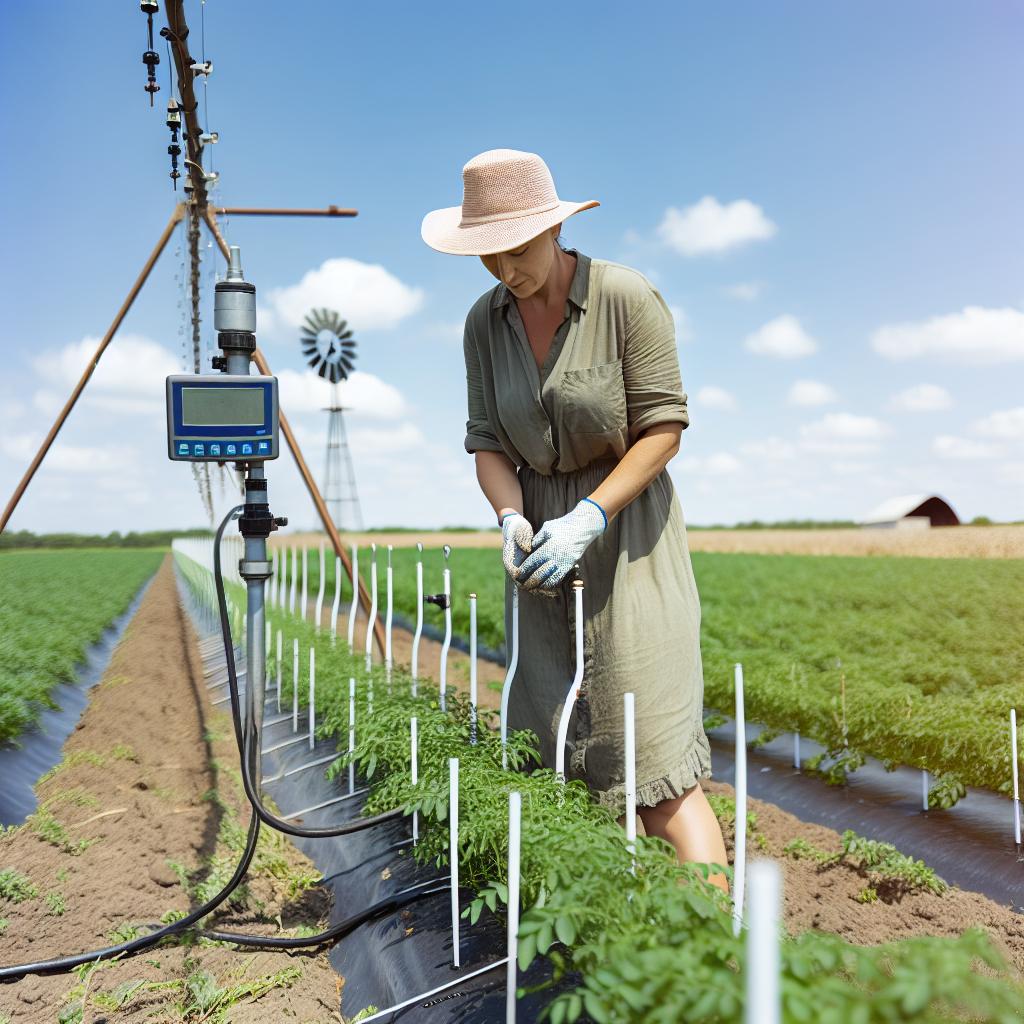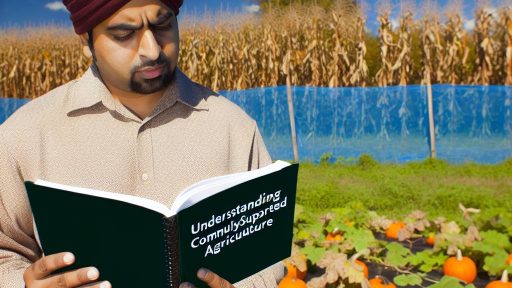Introduction to Sustainable Irrigation and Its Importance in Soil Moisture Retention
Sustainable irrigation practices are crucial for modern agriculture.
These practices enhance soil moisture retention effectively.
They help farmers manage water efficiently and sustainably.
Improving soil moisture retention is vital for crop health.
Healthy crops lead to better yields and food security.
Understanding Sustainable Irrigation
Sustainable irrigation utilizes methods that conserve water resources.
These methods aim to optimize water use while minimizing wastage.
Traditional irrigation can lead to significant water loss.
In contrast, sustainable systems reduce runoff and evaporation.
This ultimately supports long-term agricultural viability.
The Role of Soil Moisture Retention
Soil moisture retention is essential for plant growth.
It facilitates better nutrient absorption during critical growth stages.
Increased moisture availability helps crops withstand drought conditions.
Furthermore, it enhances soil structure and fertility over time.
Key Sustainable Irrigation Techniques
- Drip irrigation delivers water directly to plant roots.
- Rainwater harvesting collects and utilizes natural precipitation.
- Subsurface irrigation maintains moisture without surface runoff.
- Mulching retains soil moisture and reduces evaporation.
- Crop rotation improves soil health and moisture retention.
Implementing these techniques fosters water conservation.
Transform Your Agribusiness
Unlock your farm's potential with expert advice tailored to your needs. Get actionable steps that drive real results.
Get StartedFarmers benefit from reduced water costs and improved crop resilience.
Overview of Common Irrigation Methods and Their Environmental Impact
Traditional Irrigation Techniques
Farmers have used traditional irrigation techniques for centuries.
These methods include surface irrigation and flood irrigation.
Surface irrigation involves flowing water over the soil surface.
Flood irrigation distributes water uniformly over fields.
While effective, these methods often lead to water wastage.
Drip Irrigation
Drip irrigation delivers water directly to plant roots.
This method minimizes evaporation and runoff.
As a result, it enhances water efficiency significantly.
Farmers report higher crop yields when using drip systems.
However, initial setup costs can be high.
Sprinkler Irrigation
Sprinkler irrigation mimics natural rainfall.
It allows even distribution of water across fields.
This method can lead to overwatering if not managed well.
Additionally, it can cause soil erosion in some cases.
Nonetheless, it remains popular due to its flexibility.
Subsurface Irrigation
Subsurface irrigation relies on buried pipes to deliver water.
This technique reduces evaporation and surface runoff significantly.
By maintaining consistent soil moisture, it promotes healthy crops.
Nonetheless, installation requires careful planning and investment.
Environmental Impacts of Irrigation
Irrigation practices greatly influence local ecosystems.
Over-irrigation can lead to soil salinization over time.
Furthermore, inefficient irrigation methods waste significant water resources.
This results in reduced water availability for surrounding habitats.
Showcase Your Farming Business
Publish your professional farming services profile on our blog for a one-time fee of $200 and reach a dedicated audience of farmers and agribusiness owners.
Publish Your ProfileIn contrast, sustainable practices improve soil health and moisture retention.
Transitioning to Sustainable Practices
Farmers must evaluate their irrigation methods regularly.
Adopting sustainable practices can mitigate environmental issues.
Training programs will educate farmers on modern techniques.
Furthermore, utilizing technology can improve irrigation efficiency.
Ultimately, sustainable irrigation enhances productivity and maintains ecological balance.
Principles of Soil Moisture Retention and Its Role in Sustainable Agriculture
Understanding Soil Moisture Retention
Soil moisture retention is crucial for agricultural productivity.
It allows crops to access water during dry periods.
Moisture retention also improves soil structure and health.
The Importance of Soil Structure
Healthy soil structure enhances moisture retention capabilities.
Soul that is well-aerated retains water more effectively.
Additionally, organic matter plays a significant role in moisture retention.
Impact on Crop Yield
Moisture retention directly influences crop yield and quality.
Consistent water availability helps crops grow stronger and healthier.
Consequently, better yields support food security for communities.
Environmental Benefits
Improving soil moisture retention reduces the need for excessive irrigation.
This minimizes water wastage and promotes sustainable practices.
Furthermore, healthy soil reduces runoff and enhances water conservation.
Integrating Sustainable Practices
Farmers can adopt several sustainable practices to enhance moisture retention.
Techniques such as cover cropping and mulching can be effective.
These methods protect soil from erosion while improving moisture levels.
Additionally, utilizing organic amendments can improve soil fertility and retention.
Key Principles of Soil Moisture Retention
Understanding the principles of soil moisture retention is vital.
Implementing these practices fosters sustainable agriculture.
Ultimately, it supports both environmental health and food security.
Uncover the Details: Organic Greenhouse Farming for Year-Round Sustainable Production in the USA
Techniques for Enhancing Soil Structure to Improve Water Retention
Understanding Soil Composition
Soil composition influences its ability to retain moisture.
Healthy soils contain a mix of sand, silt, and clay.
A balanced composition promotes optimal water retention.
Thus, understanding soil components is vital for farmers.
Incorporating Organic Matter
Organic matter enhances soil structure significantly.
Materials like compost and manure improve water absorption.
Additionally, they foster beneficial microbial activity.
This activity contributes to nutrient cycling in soils.
Practicing No-Till Farming
No-till farming preserves soil structure effectively.
This practice reduces soil compaction and erosion.
Furthermore, it allows for better water infiltration.
Consequently, moisture retention improves over time.
Utilizing Cover Crops
Cover crops contribute to soil health and moisture retention.
These crops prevent erosion and enhance soil organic matter.
Showcase Your Farming Business
Publish your professional farming services profile on our blog for a one-time fee of $200 and reach a dedicated audience of farmers and agribusiness owners.
Publish Your ProfileMoreover, they help in maintaining soil temperature.
Consequently, the soil retains moisture more efficiently.
Implementing Mulching Techniques
Mulching protects soil from evaporation and erosion.
Organic mulches, like straw and bark, are beneficial.
They also suppress weeds, reducing competition for water.
As a result, soil moisture levels remain higher during dry spells.
Enhancing Soil Aeration
Aeration improves root development and moisture retention.
Methods like deep tilling or using aeration tools help.
By allowing air into the soil, roots access vital resources.
Consequently, plants become more resilient to drought conditions.
Adopting Water-Conserving Irrigation
Water-conserving irrigation methods optimize moisture retention.
Drip irrigation delivers water directly to roots.
This minimizes evaporation and runoff effectively.
Thus, plants receive the moisture they need with less waste.
Regular Soil Testing
Conducting soil tests informs on nutrient levels and pH.
This information helps in making educated amendments.
Regular testing allows farmers to adjust practices as needed.
Consequently, soil structure and moisture retention improve continuously.
See Related Content: Sustainable Farm Certification for Pesticide-Free and Non-GMO Farming
The Role of Mulching in Water Conservation and Soil Moisture Management
Understanding Mulching
Mulching involves covering the soil surface with materials.
Common materials include straw, wood chips, and grass clippings.
This practice helps retain soil moisture effectively.
Moreover, it provides insulation against temperature fluctuations.
Benefits of Mulching for Soil Moisture
Using mulch significantly reduces water evaporation.
It creates a barrier that limits direct sunlight exposure.
Consequently, soil remains cooler and moist longer.
Furthermore, mulching reduces the need for frequent watering.
This practice helps save water resources in the long run.
Types of Mulch for Optimal Moisture Retention
Organic mulch is made from natural materials.
Examples include bark, straw, and shredded leaves.
In contrast, inorganic mulch consists of materials like stones and plastic.
Both types have unique benefits for soil health.
Organic mulch enriches the soil as it decomposes.
Inorganic mulch often lasts longer and requires less maintenance.
Implementing Mulching Techniques
Proper techniques can enhance mulching effectiveness.
First, apply a layer of mulch at least three inches thick.
Additionally, keep mulch away from plant stems to prevent rot.
Regularly check and replenish mulch as it breaks down over time.
This ensures maximum moisture retention throughout the growing season.
Impact on Soil Health
Besides moisture conservation, mulching improves overall soil structure.
Showcase Your Farming Business
Publish your professional farming services profile on our blog for a one-time fee of $200 and reach a dedicated audience of farmers and agribusiness owners.
Publish Your ProfileIt enhances organic matter content as it decomposes.
In turn, this promotes beneficial microbial activity.
Healthy soil contributes to better nutrient availability for plants.
Ultimately, mulching supports sustainable agricultural practices.
Gain More Insights: Organic Pest Control Methods for Sustainable Farming in the USA
Using Rainwater Harvesting Systems for Sustainable Irrigation
Introduction to Rainwater Harvesting
Rainwater harvesting collects and stores rainwater for later use.
This method promotes water conservation and reduces dependence on groundwater.
Moreover, it helps enhance soil moisture levels effectively.
Benefits of Rainwater Harvesting
Rainwater harvesting offers a variety of benefits for sustainable irrigation.
- It provides a reliable water source during dry periods.
- This practice helps reduce the cost of irrigation.
- It improves water quality by filtering contaminants naturally.
- Additionally, it supports local ecosystems by maintaining groundwater levels.
Implementing a Rainwater Harvesting System
Implementing a rainwater harvesting system requires careful planning.
First, assess your property for optimal rain catchment areas.
Next, install a collection system to capture rainfall from roofs.
For storage, use tanks that suit your property’s water needs.
Finally, integrate the system with your existing irrigation infrastructure.
Maintenance of Rainwater Harvesting Systems
Regular maintenance ensures the longevity and efficiency of the system.
Clean gutters and downspouts to prevent debris accumulation.
Inspect storage tanks for leaks or contamination periodically.
Moreover, regularly monitor water quality for safe use in irrigation.
Maximizing Efficiency with Best Practices
To maximize efficiency, consider implementing best practices in your system.
- Use a first-flush diverter to exclude initial runoff.
- Integrate drip irrigation with harvested rainwater.
- Plant drought-resistant crops to optimize water use.
By adopting these practices, you can significantly enhance soil moisture retention.
See Related Content: Harnessing Waste to Generate Clean Energy on Farms

Benefits of Drip Irrigation and Precision Irrigation Technologies
Enhancing Water Efficiency
Drip irrigation minimizes water waste effectively.
It delivers water directly to the plant roots.
This targeted approach reduces evaporation and runoff.
Consequently, crops receive the optimal amount of water.
Farmers can conserve water significantly with this method.
Improving Soil Health
Drip irrigation promotes healthier soil biology.
It maintains consistent moisture levels in the soil.
This stability helps support beneficial microorganisms.
As a result, soil structure improves over time.
Healthy soil enhances nutrient availability to plants.
Increasing Crop Yields
Precision irrigation directly correlates with yield increases.
By ensuring adequate moisture, crops thrive better.
This leads to higher quality harvests overall.
Farmers experience less crop loss during dry spells.
More consistent yields improve profitability in farming.
Reducing Labor Costs
Automated irrigation systems reduce manual labor needs.
This efficiency allows farmers to focus on other tasks.
As a bonus, labor costs decrease significantly.
Farmers can allocate resources more strategically.
Showcase Your Farming Business
Publish your professional farming services profile on our blog for a one-time fee of $200 and reach a dedicated audience of farmers and agribusiness owners.
Publish Your ProfileAutomation also reduces the risk of human error.
Environmental Impact
Drip and precision irrigation technologies protect the environment.
They reduce the overuse of water resources.
Additionally, less water runoff minimizes nutrient leaching.
This helps preserve local water sources and ecosystems.
Drip irrigation supports sustainable agricultural practices.
The Impact of Cover Crops on Soil Moisture and Irrigation Efficiency
Enhancing Soil Structure
Cover crops improve soil structure significantly.
This enhancement promotes better water infiltration.
Additionally, improved soil structure increases aeration.
As a result, roots can access moisture more efficiently.
Reducing Erosion
Cover crops protect the soil from erosion.
They reduce surface runoff during heavy rains.
Consequently, more moisture remains in the soil.
Increasing Organic Matter
Adding cover crops boosts organic matter in the soil.
Higher organic content helps retain moisture effectively.
Moreover, it enhances soil fertility over time.
Optimizing Water Usage
Cover crops play a crucial role in optimizing water usage.
They use soil moisture but prevent over-extraction.
This ensures that moisture remains available for future crops.
Encouraging Beneficial Microorganisms
Cover crops create a habitat for beneficial microorganisms.
These microorganisms contribute to moisture retention.
Moreover, they assist in nutrient cycling for plants.
Strengthening Drought Resilience
Using cover crops increases drought resilience in soils.
Thus, crops maintain productivity even during dry spells.
This resilience is crucial for sustainable agriculture.
Integrating Climate-Smart Agriculture Practices for Sustainable Irrigation
Understanding Climate-Smart Agriculture
Climate-smart agriculture aims to enhance productivity sustainably.
It focuses on adapting to climate change while reducing greenhouse gas emissions.
Farmers can use various practices to achieve these goals.
Utilizing Efficient Irrigation Techniques
Efficient irrigation techniques are essential for water conservation.
Drip irrigation provides water directly to plant roots.
This method minimizes water loss and maximizes efficiency.
Moreover, sprinkler systems can be adjusted for optimal coverage.
Implementing Water Harvesting Methods
Water harvesting techniques collect rainwater for irrigation use.
Systems like rain barrels and cisterns capture rainwater effectively.
This practice reduces dependency on groundwater sources.
Additionally, it helps mitigate runoff and erosion.
Promoting Soil Health
Healthy soil enhances moisture retention and fertility.
Practices like cover cropping contribute to soil structure and biodiversity.
Crop rotation diversifies crops and improves nutrient usage.
Integrated pest management further supports soil and crop health.
Showcase Your Farming Business
Publish your professional farming services profile on our blog for a one-time fee of $200 and reach a dedicated audience of farmers and agribusiness owners.
Publish Your ProfileAdjusting Planting Schedules
Adapting planting schedules helps align with climate patterns.
Farmers can select drought-resistant crops to reduce water needs.
Moreover, planting during optimal weather conditions maximizes yields.
Monitoring and Evaluation
Regular monitoring gives insight into soil moisture levels.
Using soil sensors can guide irrigation decisions effectively.
Farmers should evaluate the results of implemented practices periodically.
This feedback loop encourages continuous improvement and adaptation.
Case Studies of Successful Sustainable Irrigation Practices and Their Outcomes
Coffee Farm in Costa Rica
A coffee farm in Costa Rica implemented drip irrigation technology.
This system minimized water wastage while maximizing soil moisture retention.
As a result, the farm observed a 30% increase in coffee yield.
Farmers reported improved product quality and lower costs over time.
Alfalfa Fields in California
In California, farmers used cover crops alongside traditional irrigation.
These cover crops enhanced soil structure and moisture levels.
The outcome was a significant reduction in their water usage.
This approach helped maintain crop productivity during drought seasons.
Organic Vegetable Farm in Italy
An organic vegetable farm in Italy adopted a rainwater harvesting system.
They collected and stored rainwater for irrigation purposes.
This practice reduced their dependence on groundwater sources.
Consequently, they enjoyed better soil health and higher crop resilience.
Rice Paddy Systems in Cambodia
Farmers in Cambodia implemented alternate wetting and drying (AWD) practices in rice paddies.
This technique improved soil aeration while saving water.
As a result, they experienced a 20% increase in rice production.
This sustainable method enhanced soil moisture retention compared to traditional flooding.
Community Gardens in Urban Areas
Urban community gardens often use smart irrigation systems.
These systems optimize water delivery based on plant needs.
Participants reported healthier plants and increased community engagement.
Moreover, these gardens serve as green spaces in urban environments.
Fruit Orchards in Australia
A fruit orchard in Australia utilized soil moisture sensors for irrigation management.
This technology allowed precise water application.
As a direct result, the orchard saw reduced water costs and healthier fruit trees.
Additionally, they minimized the risk of overwatering and root diseases.
Additional Resources
Agriculture Innovation Mission for Climate (AIM for Climate) on …
Bill Alert! US Senate Bill S 2611 – Snow Survey Northeast Expansion …




